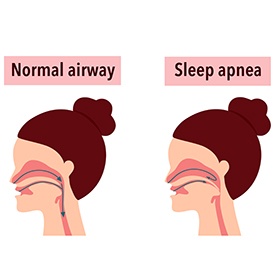Obstructive Sleep Apnea Fort Worth
An Introduction to OSA

Obstructive sleep apnea (OSA) is one of the most common sleep disorders in Fort Worth and throughout the world. Are you well-informed about this dangerous condition? On this page, we provide a comprehensive introduction to OSA and offer guidance that will help you decide when/if you should seek professional care to improve the quality of your sleep. You are welcome to contact us if you have any questions about what you learn here.
What Is Obstructive Sleep Apnea?

Obstructive sleep apnea is a disorder marked by repeated pauses in breathing, or episodes of restricted breathing, during sleep. These incidents, known as apneas and hypopneas, may occur dozens or even hundreds of times in a single night.
The obstructive part of this condition’s name comes from the fact that the pauses in breathing occur when tissues in the upper airway collapse and fully or partially obstruct the free flow of oxygen. The guilty tissue may be the tongue, soft palate, or uvula.
Causes of Obstructive Sleep Apnea

OSA can have a number of different causes. Some of the most common include:
- Extra fatty tissue. Having extra fat around the neck makes it more likely that the airway will collapse. Therefore, OSA is more common among obese individuals.
- Anatomical abnormalities. Misaligned teeth, a narrow palate, or a deviated nasal septum could all contribute to OSA.
- Menopausal and postmenopausal women are at an increased risk of OSA due to hormonal changes.
- Loss of muscle tone. Older adults often lose muscle tone throughout their body, including in the muscles that control breathing.
Possible Complications of Obstructive Sleep Apnea

OSA can lead to some short-term and long-term complications, including:
- Increased risk of accidents. OSA disrupts your sleep cycle and can leave you feeling exhausted. Your reaction times may be slow, which increases the risk of being involved in a car crash or another type of accident.
- Impact on your daily activities. OSA can negatively affect your performance at work. It may also increase your risk of mood disorders and sexual dysfunction.
- Cardiovascular health issues. OSA is linked to a heightened risk of high blood pressure, heart attack, and stroke.
- Weight gain. Weight gain can contribute to the development of OSA, but the reverse is also true. OSA can interfere with the hormones that control hunger and satiety, leading you to overindulge in high-calorie foods.
When Should You See a Doctor?

Here are some signs that you should talk to a medical professional about getting tested for obstructive sleep apnea:
- You snore loudly and frequently.
- You always feel tired despite spending 7 – 8 hours asleep.
- A family member has informed you that you sometimes stop breathing during sleep.
- You often wake up with a headache or sore throat.
- You sometimes wake up gasping for air.
Remember, sleep apnea is unlikely to go away on its own. In fact, it may get worse with time. The sooner you seek care, the sooner you can get back to enjoying the high-quality rest that your body needs!
